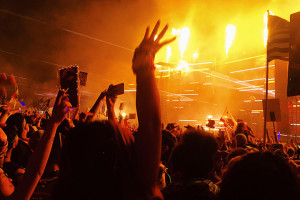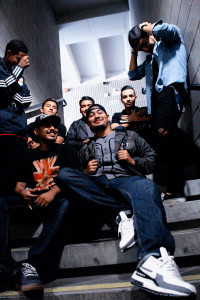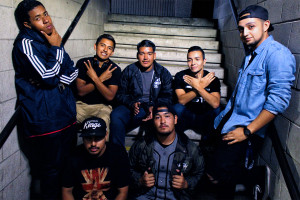Rave On: Students get DIY with the rave scene
Because of illegal substance abuse and drug related deaths, raves are getting pushed farther away from Southern California. In order to keep the party going, a group of Citrus College students has decided to bring the good times home.

Photo from Nocturnal Wonderland in San Bernardino. The massive EDM music festival held on Labor Day weekend ended with 176 people arrested, mostly for being under the influence of drugs and alcohol. (Photo: Cheyenne Falcon/Logos)
Today, raving is viewed as mainstream. Raves are getaways that call college students in particular to swarm en masse to each event.
Raving started in Manchester, England, after Chicago DJs introduced house music to the UK party scene. Social outsiders of the ‘80s were looking for a place where they could simply be themselves and find other like-minded people. They soon made home to the dark alleys and backdoors that would lead them inside dark Manchester warehouses. There a subculture was born, they would drop acid and dance the night away. From these nights in Manchester. It wasn’t long until America caught onto the UK rave scene and quickly adopted the lifestyle.
Ravers of the ‘90s seem like an evolutionary extension of the Beatniks, hippies, and disco days. They idealized being dangerously free and fearlessly creative. They found a way to not only create an entirely new genre of music but also a radical new counterculture. Their community thrived on energy and emotion. At their core, they were fighting for peace, love, unity, and respect. Millennial ravers are much different.
The way young people rave today is less than authentic. Raves have moved from abandoned warehouses and country fields to giant raceways and convention centers.
Raving has completely lost its meaning. The magic that came with its secrecy is gone. The counterculture has been exploited and eaten up by commercial monsters who charge a $100+ for a single day ticket. The worst part of these commercialized spectacles is that they often end up attracting people who are looking for a chance to experiment with drugs.
Information gathered by the Addiction Center indicates that full-time college students are at twice the risk of abusing substances as compared to people who are not enrolled in college. A lot of inexperienced youth who want to dabble in drugs for recreational use assume that raves are where you go to try drugs.
“I know a lot of people go to raves just to do drugs. If I go, I’m probably gonna be tripping on something,” said 18-year-old Serena C., undeclared. “If it’s my first time, I want to have the full experience.” Although Serena has experienced seizures triggered by stress and feeling overwhelmed, she is still willing to risk trying designer drugs to fully experience the rave culture.
In the past 10 years, there have been 25 confirmed drug-related deaths tied to these commercial raves, according to the Los Angeles Times. This statistic does not include the three deaths that happened at HARD Summer in July 2016. Half of those deaths occurred in Southern California. Ten of those lost lives were college students.
The most notorious case was that of 15-year-old Sasha Rodriguez, who snuck into Insomniac’s Electric Daisy Carnival at the Los Angeles Memorial Coliseum in 2010. While at the festival, Rodriguez consumed an Ecstasy pill, which resulted in shocked lungs and brain damage. Rodriguez is one of many who have died from Ecstasy overdoses, but hers was the case that ultimately led to the development of the Los Angeles “Electronic Music Task Force.”
The purpose of the task force is to monitor activity at raves to make sure that they are as safe as possible. If a problem arises, then it is up to the task force to issue new regulations to maintain safe and legal raving. Rodriguez’s death led to changes such as the 18+ age requirement, free water stations, heightened security and even amnesty boxes where ravers can drop illegal substances before entering with no consequences.
Still, not much has changed. People are still overdosing, and the reputation of raving remains questionable at best.
With so much controversy within the rave scene, many EDM event companies are feeling the pressure to leave Southern California and relocate their events elsewhere. Local venues, such as the Pomona Fairplex, simply refuse to hold EDM festivals. With raves staged farther and farther away from Los Angeles, all that local ravers can do is implement the DIY style, a throwback to how raves used to be.

The Buchanan’s Boys. Back row (left to right): Yobane Bernal, Richard Ramirez, Antonio Becerra, Adolfo Delgado, and Gabriel Ibarra. Front row (left to right): Edgar Avellaneda and Brandon Giron (Photo by: Megan Bender)
Like the Buchanan’s Boys from Azusa.
Named after a popular brand of whiskey, the Buchanan’s Boys are a party crew made up Citrus College students Brandon Giron, 19, criminology major, Edgar Avellaneda, criminology major, Yobane Bernal, undeclared; Gabriel Ibarra, business; Antonio Becerra, business; and Adolfo Delgado, kinesiology.
“We’re here for people who want to dance. That’s what we’re about,” Giron said.
They have been hosting and promoting house parties throughout the San Gabriel Valley for about two years.
“We would go to parties together, and things would get out of hand,” Giron said. “The whole party would start fighting, so we were like, ‘Why can’t we make a party just for the environment?’ We love the music, and we don’t want the violence at parties, so let’s just make our own party crew and start throwing our own parties.”
The Buchanan’s Boys have known each other since elementary school. They developed their love for partying, EDM and dancing while they were in high school.
“We’re like brothers, basically. For us it’s always cool being together and just enjoying the music,” Ibarra said. Ibarra also said he believes that these house parties will help him along in his field of study.
“I’m a communications major, and I’m all about that. That’s part of why I got into this, to make people feel good,” Ibarra said. “It’s practicing what I want to do because I’m socializing with a lot of people.”
For the Buchanan’s Boys, socializing and having a good time is what matters. Their parties are free so people can enjoy themselves at no expense. They are also sober at most of their events despite their alcohol-inspired name.
“We surround ourselves with people that aren’t in it for the drugs and stuff,” Giron said. “We’re all about dancing and just having fun. People say let’s drink or let’s get crazy, but that’s not what we’re about. We’re there to enjoy the music with our friends.”
Their policy of no drugs comes from first-hand experiences of over consumption. Giron recalls a time where he had to drive a friend to the hospital. His friend was having seizures caused by an unknown drug that he took at a house rave.
“We had to get him to the hospital fast, and it really scared me. I started taking more precautions. When they invite us to host parties, now they have to tell me ahead of time before the party starts so I can check for illegal substances from the beginning.”

The Buchanan’s Boys (Photo: Megan Bender)
Giron prefers to have no drugs at his raves but he knows that sometimes people get sneaky. A lot of the house raves that the Buchanan’s Boys put on are hosted at Giron’s own residence, which puts him and his family at risk.
“That a major reason I don’t do drugs because my mom is always there,” said Giron. “She’s OK with us doing the parties just as long as we do it right.”
“We try not to go overboard because we still have to take care of the house,” Becerra said.
Delgado, who is the personal DJ for the Buchanan’s Boys and provides all the music for their parties is always cautious to avoid partying excessively during these home raves so he can take care of this DJ equipment.
“I started through my brother. He had a DJ set that he bought a long time ago, and he just had it in his closet,” Delgado said. “One day I asked him how to use it, and he told me how, so I started practicing. I’m not that good, but I just kept practicing and then I started getting gigs and just like that, it started happening.”
The Buchanan’s Boy always have each other’s back which is part of the reason their raves work. They don’t know how long they’ll keep going, but they don’t want to stop anytime soon.
Even if the Buchanan’s Boys put an end to their party crew days, they anticipate staying close to the community that they have created.
“I feel like we’re all united,” Ibarra said. “We all get along with each other and all have something in common. We all have that unity that keeps us together through the music.”



